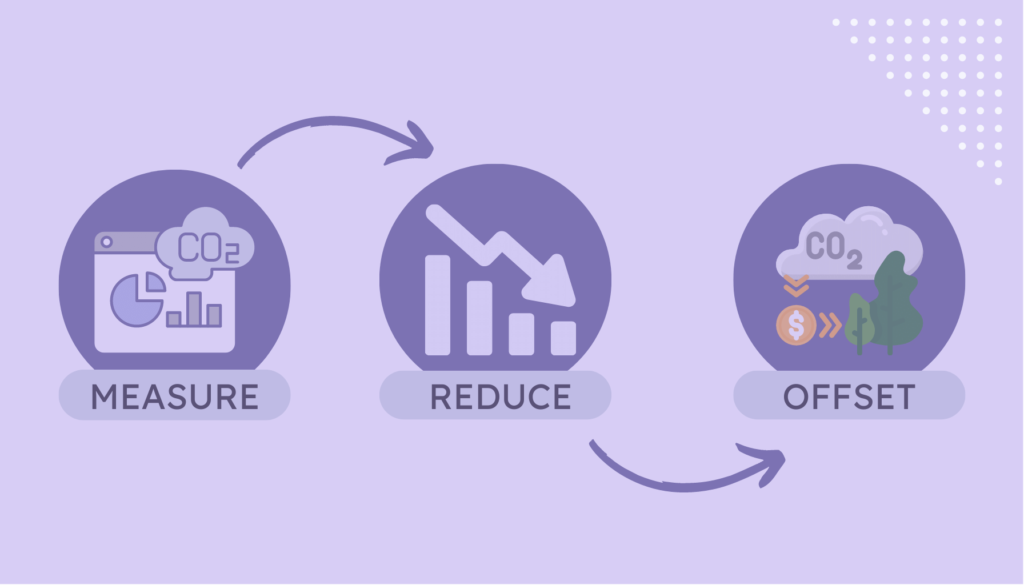
What is a Digital Carbon Footprint?
As we continue to rely more and more on technology in our daily lives, it’s important to understand the impact our digital activities have on the environment. Our digital carbon footprint refers to the number of greenhouse gases (primarily carbon dioxide) that are produced as a result of our use of digital devices and services.
Everything from sending an email to streaming a movie contributes to our digital carbon footprint. In fact, the technology sector is responsible for roughly 2% of global greenhouse gas emissions, a number that is expected to continue to grow as our reliance on technology increases. To put that into perspective, that’s roughly equivalent to the entire aviation industry. This means that addressing our digital carbon footprint is a critical part of any effort to combat climate change.
Automatically Make Your Website Carbon Neutral
Pathmonk Climate automatically offsets your emissions through high-quality climate projects, while analyzing and calculating your website’s carbon footprint. Showcase your climate actions with your zero-emission website certificate.

The Importance of Addressing Your Company’s Digital Carbon Footprint
As major users of digital technology, companies have a larger digital carbon footprint than individuals. So they have a unique responsibility and opportunity to take influential action when it comes to climate change. Here are some key strategies that your organization can take to reduce your digital carbon footprint and ultimately promote sustainability.
- Use renewable energy: Switching to renewable energy sources such as solar, wind, or hydroelectric power can not only help the environment but can also save you money in the long run. And who doesn’t like saving some money while simultaneously saving the planet?
- Optimize data centers: Data centers collectively contribute to 2% of the total global greenhouse gas emissions; they are a major contributor to our digital carbon footprint. From reducing data transfer to sustainable web design to renewable energy sources, you can reduce the impact by optimizing your data centers to be more energy-efficient.
- Encourage remote work: From reduced transportation to reduced energy consumption in the office, remote work can help reduce carbon emissions. And as this world shifts to remote work and people-first mindsets you’ll be improving your company culture while reducing your digital carbon footprint.
- Implement carbon offsetting: We can’t always stop producing carbon emissions but we can always offset our carbon emissions. By investing in carbon offset projects such as reforestation or renewable energy you can compensate for your emissions by funding an equivalent carbon dioxide saving elsewhere.
- Promote circular economy: Reduce, reuse, recycle. The phrase has been drilled into our heads since school. It is a simple concept that can become part of your everyday business operations. You can implement everyday best practices and take it further by promoting a circular economy by reusing or recycling electronic devices to reduce the demand for new technology.
Addressing your company’s digital carbon footprint is an essential part of a sustainable business strategy. By taking clear, decisive, and impactful action, you can demonstrate your commitment to environmental responsibility and reduce the impact on our planet.
Understanding Carbon Offsetting for Companies
With the increasing concerns surrounding climate change, companies around the world are looking for ways to create sustainable environments, reduce emissions, and drive foundational change. One effective way that you can do this is by participating in carbon offsetting programs. In this section, we will explore the basics of carbon offsetting, how it works, and the different types of carbon offsets that you can purchase.
Definition of Carbon Offsetting
Carbon offsetting is a way for companies to compensate for their carbon emissions by investing in carbon reduction projects. Essentially, carbon offsets are a type of credit that represents a reduction of greenhouse gas emissions. When a company purchases carbon offsets, they are essentially paying for someone else to reduce emissions on its behalf. This is done through various types of projects, such as renewable energy projects or forest conservation efforts.
How Carbon Offsetting Works
Carbon offsetting works by creating a market for emission reductions. Companies that are unable to reduce their own emissions to meet their targets can purchase carbon offsets to make up the difference. For example, if a company emits 100 tons of carbon dioxide per year but has a target of only emitting 50 tons, it can purchase 50 tons of carbon offsets to offset its remaining emissions.
To ensure the legitimacy of the carbon offsets, they must meet certain criteria. This includes being verifiable, and permanent. Additionally, the projects that generate carbon offsets must be registered with an internationally recognized carbon standard.
When a company purchases carbon offsets, they are essentially supporting a project that reduces carbon emissions in another location. For example, a company might invest in a wind farm project in India that generates clean energy, which reduces the need for fossil fuels and therefore reduces emissions. As a result, the company receives credits for the avoided carbon emissions.

Types of Carbon-Offset Projects
There are many different types of carbon offsets that you can purchase, each with its own benefits and drawbacks. Some of the most common types of carbon offsets include:
- Renewable Energy: Renewable energy projects, such as wind or solar farms, generate clean energy that replaces the need for fossil fuels and supports the transition to a low-carbon energy system.
- Energy Efficiency: These projects involve improving the energy efficiency of buildings, factories, or equipment. This reduces the amount of energy needed and therefore reduces emissions.
- Forest Conservation: Forest conservation projects involve protecting forests from deforestation or degradation. Trees absorb carbon dioxide from the atmosphere, so protecting forests can help to reduce emissions.
- Methane Capture: Methane is a potent greenhouse gas that is emitted from sources such as landfills or livestock. Methane capture projects involve capturing methane and using it as an energy source.
- Agriculture: Agriculture projects involve practices that reduce emissions from farming, such as reducing fertilizer use or changing the way livestock are raised.
It is important to note that not all carbon offsets are created equal. It’s critical that you carefully research the projects you are investing in to ensure that they are legitimate and effective at reducing emissions. You should also consider working with reputable organizations that specialize in carbon offsetting to help you navigate the complex world of carbon credits.
By purchasing carbon offsets, you can support projects that reduce emissions in other locations and help to mitigate the impact of climate change. It is an effective way for companies to reduce their carbon footprint and support the transition to a low-carbon economy.
Achieving Carbon Neutrality for Companies
In today’s world, the issue of climate change has become more pressing than ever before. The world’s leading climate scientists have issued a stark warning that time is running out to mitigate global warming and prevent catastrophic climate events. To combat this issue, many companies have taken a step toward achieving carbon neutrality.
Benefits of Achieving Carbon Neutrality
Achieving carbon neutrality has several benefits for companies. Firstly, it demonstrates a commitment to sustainability and environmental responsibility, which can improve a company’s reputation and brand image. Secondly, it can lead to cost savings through increased efficiency and reduced energy consumption. Lastly, it can help future-proof a company against the risks of climate change and potential regulatory changes.

Steps to Achieving Carbon Neutrality
To achieve carbon neutrality, you need to take a comprehensive approach that involves measuring, reducing, and offsetting carbon emissions.
1. Measuring Carbon Footprint
The first step towards achieving carbon neutrality is to measure your carbon footprint. This involves calculating the number of carbon emissions that are produced through your operations, such as energy consumption, transportation, and waste disposal. By measuring your carbon footprint, you can identify the areas that are responsible for the majority of emissions and prioritize efforts to reduce them.
2. Reducing Carbon Emissions
The second step towards achieving carbon neutrality is to reduce your carbon emissions. This involves implementing a range of strategies to increase energy efficiency, switch to renewable energy sources, and reduce waste. For example, you can invest in energy-efficient equipment, implement recycling programs, and encourage employees to use public transportation or work from home.
3. Offsetting Remaining Emissions
The final step towards achieving carbon neutrality is to offset any remaining carbon emissions through the purchase of carbon credits or investments in carbon offset projects. Carbon credits are a type of tradable permit that represents one ton of carbon dioxide equivalent, while carbon offset projects involve investing in renewable energy projects or reforestation programs that reduce or remove carbon emissions from the atmosphere.
Examples of Companies that have Achieved Carbon Neutrality
There are a growing number of companies around the world that are taking action to achieve carbon neutrality. Here are just a few examples of companies that have successfully achieved carbon neutrality:
- Microsoft:
Microsoft has pledged to be carbon negative by 2030 and to remove all of its historical carbon emissions by 2050. The company has invested in carbon offsets, green energy, and new technologies to reduce its carbon footprint.
- Unilever:
Unilever, one of the world’s largest consumer goods companies, has achieved carbon neutrality across its operations since 2020. The company has implemented a number of measures to reduce its emissions, including investing in renewable energy, reducing waste, and using sustainable materials in its products.
- Danone:
Danone, a French multinational food company, achieved carbon neutrality across all of its global operations in 2020. The company has reduced its carbon emissions by investing in renewable energy, optimizing its transportation, and improving its manufacturing processes.
- Salesforce:
Salesforce, a global cloud computing company, achieved carbon neutrality across its entire business in 2020. The company has implemented a number of measures to reduce its emissions, including using renewable energy, improving its data centers’ efficiencies, and reducing its travel-related emissions.
- Google:
Google has been carbon neutral since 2007 and achieved carbon neutrality across its entire business, including its data centers and offices, in 2017. The company has invested in renewable energy and has been using 100% renewable energy to power its data centers and offices since 2018.
These are just a few examples of companies that have successfully achieved carbon neutrality. It is clear that many companies are taking the initiative to reduce their carbon footprint and take action on climate change. By following in the footsteps of these companies and implementing effective carbon reduction measures, you can make a significant impact on the fight against climate change.

Trends in Carbon Offsetting
As more and more companies commit to achieving carbon neutrality, the market for carbon offsetting is expected to grow significantly. The trend towards greener practices is becoming increasingly popular, with companies looking for more sustainable and environmentally friendly ways of doing business.
One of the current trends in carbon offsetting is the shift towards more local, community-based projects. This approach has many benefits for companies, as it allows them to invest in the communities they operate in, create a positive impact, and reduce their carbon footprint. These projects often include initiatives such as reforestation, building clean energy infrastructure, and supporting sustainable agriculture.
As mentioned earlier, the focus on renewable energy and energy efficiency is expected to increase, with many companies opting for renewable energy credits to offset their carbon emissions. The use of renewable energy credits is becoming increasingly popular as companies look for ways to reduce their dependence on fossil fuels and invest in renewable energy sources. In addition, companies are seeking energy-efficient solutions to reduce their energy consumption and lower their carbon footprint.

The demand for carbon-neutral certifications and standards is also on the rise. Companies are looking for ways to ensure that their carbon offsetting efforts are credible, verifiable, and consistent with global standards.
Companies like Pathmonk Climate are even helping businesses like yours automate their carbon offsets and easily achieve a carbon-neutral certification. Pathmonk Climate automatically offsets your website emissions through high-quality climate projects, while analyzing your website’s carbon footprint. You can calculate your website’s CO2 emissions and receive a customized website emission report.
Carbon neutral certifications are gaining in popularity, as they provide a clear and measurable framework for companies to achieve carbon neutrality. It is an opportunity to showcase actions against climate change and ultimately encourage others to do the same.
However, despite the growth of the carbon offsetting market, there are limitations to this approach. Critics argue that carbon offsetting should not be seen as a substitute for reducing carbon emissions, but rather as a complementary strategy. The use of carbon offsetting may also lead to the displacement of emissions, as companies rely on offsetting projects to compensate for their emissions rather than reducing their carbon footprint.
Innovations in Carbon Offsetting
As the world moves towards a more sustainable future, innovations are emerging to address some of the limitations of the current system. One of the most promising innovations is the use of blockchain technology to verify carbon offsets. The decentralized nature of blockchain provides a secure and transparent way to track the movement of carbon offsets and ensure that they are not double-counted or fraudulent. This is particularly important as more and more companies begin to invest in carbon offsets to achieve their carbon neutrality goals. By using blockchain, companies can have confidence in the integrity of their carbon offset investments, and consumers can be assured that their purchases are making a meaningful impact.
In addition to blockchain, machine learning is also being explored as a way to predict the effectiveness of carbon offset projects. Machine learning algorithms can analyze vast amounts of data to identify the most effective carbon offset projects and predict their environmental impact. This can help companies make more informed decisions about which projects to invest in and reduce the risk of investing in ineffective projects. Machine learning can also help to optimize existing projects by identifying areas where improvements can be made to increase their effectiveness. With the right data and analytics, companies can ensure that their carbon offset investments are making a real impact on the environment.
Conclusion
Taking action toward achieving carbon neutrality is not only important for the environment, but also for the long-term success and sustainability of businesses. By investing in sustainable practices and offsetting your carbon emissions, you can create a positive impact on the planet, while also improving your bottom line and reputation. The time to act is now, and companies must be proactive in taking steps toward carbon neutrality for the betterment of the planet and future generations.
The future of carbon offsetting is expected to be influenced by several factors, including trends in the market, the development of certifications and standards, the limitations of the current system, and innovations in the field. To make the most of carbon offsetting, you should stay up-to-date with these trends and innovations and continue to prioritize the reduction of carbon emissions. By doing so, you can achieve your sustainability goals and help create a better future for our planet.
Automatically Make Your Website Carbon Neutral
Pathmonk Climate automatically offsets your emissions through high-quality climate projects, while analyzing and calculating your website’s carbon footprint. Showcase your climate actions with your zero-emission website certificate.








